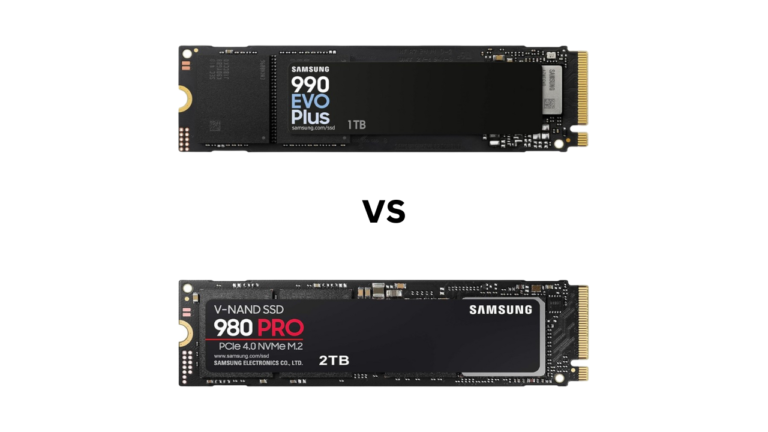Affiliate Disclosure: This post may include affiliate links. If you click and make a purchase, I may earn a small commission at no extra cost to you.
Both the Crucial T500 and the WD Black SN7100 are modern, high-end Gen 4.0 NVMe SSDs. In a way, they are competitors because of their similar offerings. But there are numerous differences when we dig deeper into the specifications.
First of all, the SN7100 is a DRAM-less SSD, which means slower, less consistent performance, especially under heavy or random workloads. The T500 has its own DRAM, which is a good thing. However, the SN7100 uses HMB (Host Memory Buffer), which essentially uses a small portion of your system’s RAM for critical tasks. HMB has become so smart today that it is hard to see any difference in day-to-day tasks. It allows manufacturers to cut costs, reduce heat and power consumption. However, for random and sustained read/write performance, having an on-chip DRAM is a good thing. So, the T500 has an advantage here.
The Crucial T500 comes with Micron’s 232-layer B58R FortisFlash, while the SN7100 has Kioxia’s 218-layer BiCS8. Kioxia’s BiCS8 has a higher performance ceiling (faster I/O, advanced architecture) and is more future-oriented, whereas Micron’s B58R FortisFlash is more of a value-optimized, high-density solution, which seems more balanced. Keep in mind that performance is never determined solely by NAND flash. Firmware optimization also plays a vital role.
SN7100 has its own WD Polaris 3 controller with 4 channels and is based on a 16 nm process. It is focused on more cost-sensitive markets. The E25 controller in the T500 is designed for flagship-tier SSDs, aiming for ~7,000+ MB/s reads/writes and high random I/O figures. So, the T500 has an edge here again.

There are several other similarities and differences between these two drives. So, with this comparison, let’s reveal all of them and reach a final decision.
Theoretical Specifications Comparison
| Specification | Crucial T500 | WD Black SN7100 |
|---|---|---|
| PCIe Generation/NVMe Version | PCIe Gen 4.0 x4 / NVMe 2.0 | PCIe Gen 4.0 x4 / NVMe 1.4 |
| Release Date | Oct 31st, 2023 | Nov 21st, 2024 |
| Capacities | 500GB, 1TB, 2TB, 4TB | 500GB, 1TB, 2TB, 47 |
| NAND Flash | Micron’s B58R FortisFlash TLC (232-layer) | Kioxia’s BiCS8 TLC (218-layer) |
| Sequential Read Speed | 500GB: 7,200 MB/s 1TB: 7,150 MB/s 2TB: 7,400 MB/s 4TB: 7,000 MB/s | 500GB: 6,800 MB/s 1TB: 7,250 MB/s 2TB: 7,250 MB/s 4TB: 7,000 MB/s |
| Sequential Write Speed | 500GB: 5,700 MB/s 1TB: 6,300 MB/s 2TB: 7,000 MB/s 4TB: 6,900 MB/s | 500GB: 5,800 MB/s 1TB: 6,900 MB/s 2TB: 6,900 MB/s 4TB: 6,700 MB/s |
| Random Read Speed | 500GB: 800K IOPS 1TB: 850K IOPS 2TB: 1,180K IOPS 4TB: 1,050K IOPS | 500GB: 760K IOPS 1TB: 1,000K IOPS 2TB: 1,000K IOPS 4TB: 900K IOPS |
| Random Write Speed | 500GB: 1,390K IOPS 1TB: 1,350K IOPS 2TB: 1,440K IOPS 4TB: 1,350K IOPS | 500GB: 1,200K IOPS 1TB: 1,400K IOPS 2TB: 1,400K IOPS 4TB: 1,350K IOPS |
| DRAM | LPDDR4 DRAM | No (HMB) |
| Heatsink Option | Yes | No |
| Price | 1TB starting at $91.99 | 1TB starting at $79.90 |
The Crucial T500 is clearly the more advanced drive. It uses the newer NVMe 2.0 interface, onboard LPDDR4 DRAM, and Micron’s 232-layer B58R FortisFlash TLC NAND, all tuned for consistency and sustained throughput.
The WD Black SN7100, launched a year later, uses Kioxia’s 218-layer BiCS8 TLC NAND with no onboard DRAM (relying on Host Memory Buffer), which helps keep costs down but limits performance stability under sustained or random workloads.
While both drives push impressive sequential speeds around 7 GB/s, the T500 advertises higher random performance and better thermal headroom thanks to its heatsink option and higher-end controller architecture. In essence, the T500 is the performance-tuned, professional-grade option; the SN7100 is the leaner, cost-efficient pick for everyday power users.
Benchmark Scores Comparison
The benchmark scores are for the 2TB variants of both drives.
PCMark 10 Full Drive Benchmark
The PCMark 10 Storage benchmark is a trace-based benchmark software that tests a drive’s capabilities in various real-world tasks like photo editing, video editing, file editing, etc.
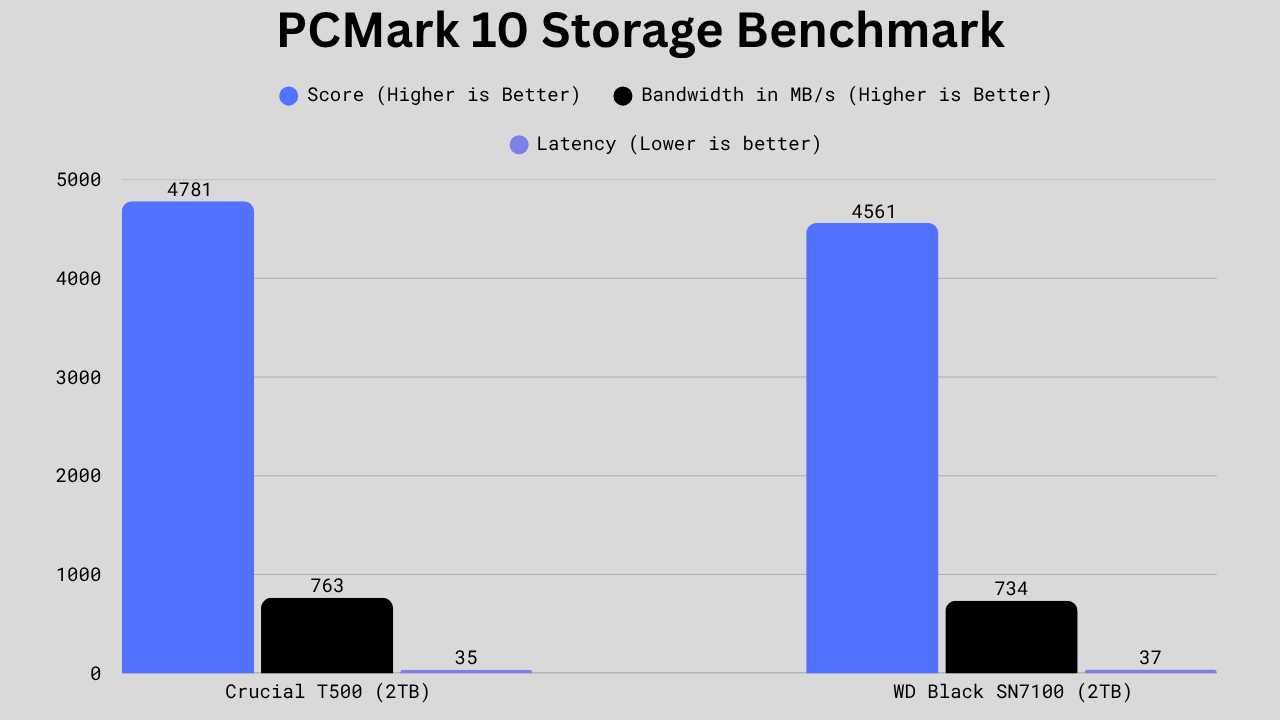
In the PCMark 10 Benchmark, the Crucial T500 scores 4781, slightly ahead of the WD Black SN7100’s 4561. That edge carries over to bandwidth as well, with 763 MB/s versus 734 MB/s. Latency is also a touch lower at 35.0 ms, down from 37.0 ms, which helps with responsiveness. Overall, the Crucial T500 delivers stronger performance across the board and is better suited for demanding tasks, while the SN7100 still performs well enough for everyday computing.
3DMark Storage Test for Gamers
The 3DMark storage test for gamers evaluates a drive’s capabilities for gaming-related tasks such as game installation, loading, saving, and streaming.

The Crucial T500 pulls clearly ahead here with a 3DMark score of 5,068 compared to the WD Black SN7100’s 4,068. That’s a sizable jump, showing stronger overall storage performance in gaming. Its bandwidth is higher, too, at 882 MB/s compared to 710 MB/s. Latency also favors the T500 at 36 microseconds versus 45, so it reacts faster to requests. Simply put, the Crucial T500 is the better performer overall, especially for gaming, creative workloads, or any task where speed and responsiveness matter most.
CrystalDiskMark Sequential Read/Write Performance
To check the peak sequential read/write speeds and compare them correctly, we have chosen 1 MiB data blocks at the queue depths of 1 and 8.

The Crucial T500 pushes stronger read speeds at both low and high queue depths with 5,809 MB/s for QD1 and 7,120 MB/s for QD8, compared to the SN7100’s 5,012 MB/s and 7,137 MB/s. Interestingly, the WD drive takes a small lead in write speeds, reaching 6,040 MB/s at QD1 and 6,860 MB/s at QD8, while the T500 trails slightly. In short, the T500 is the faster reader, great for loading large files and games quickly, while the SN7100 performs better in write-heavy situations like data backups or video rendering.
CrystalDiskMark Random Read/Write Performance
To check the peak random read/write speeds of these SSDs, we have used 4KB data blocks at the queue depths of 1 and 256.
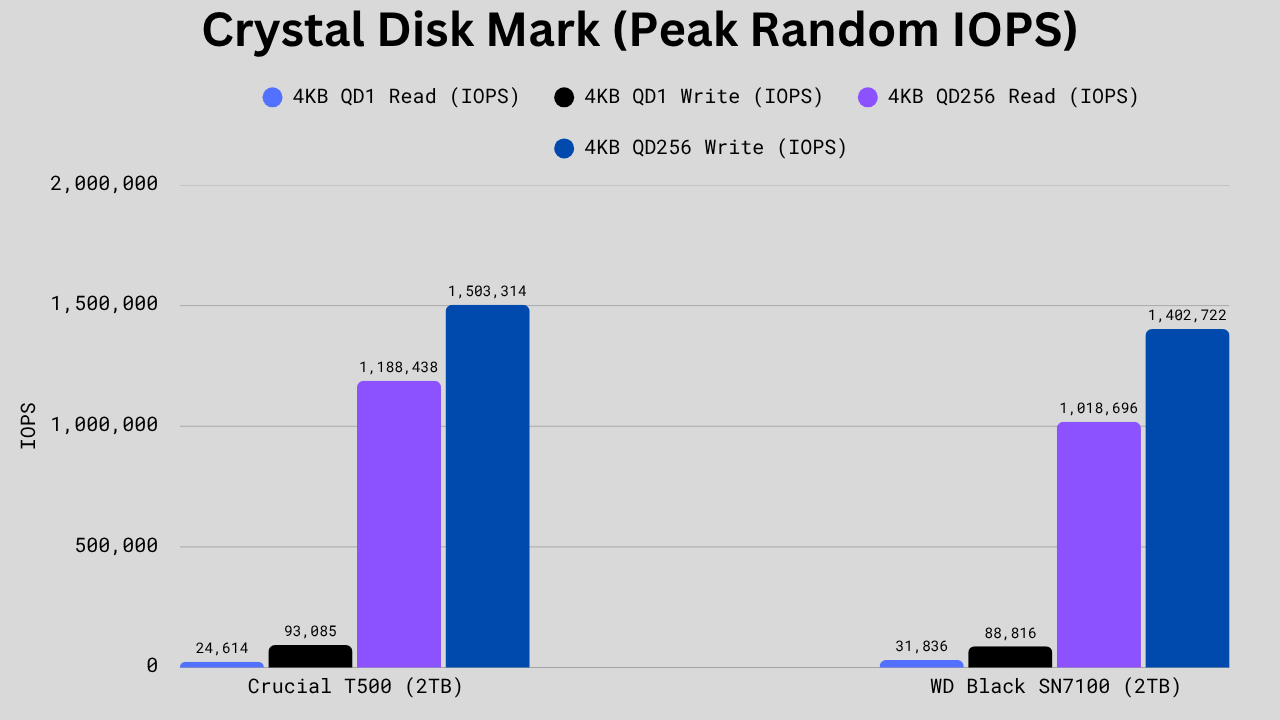
The WD Black SN7100 starts strong at low queue depths, pulling ahead in 4KB QD1 read performance with 31,836 IOPS against the Crucial T500’s 24,614. However, in the higher queue depths, the T500 takes over with 1,188,438 IOPS in 4KB QD256 reads and 1,503,314 in writes, both higher than the SN7100’s 1,018,696 and 1,402,722. Write speeds are close overall, with the Crucial just edging out the others. So, the SN7100 feels snappier for light everyday use, but the T500 dominates for heavier, multi-threaded workloads.
File Transfer Rate
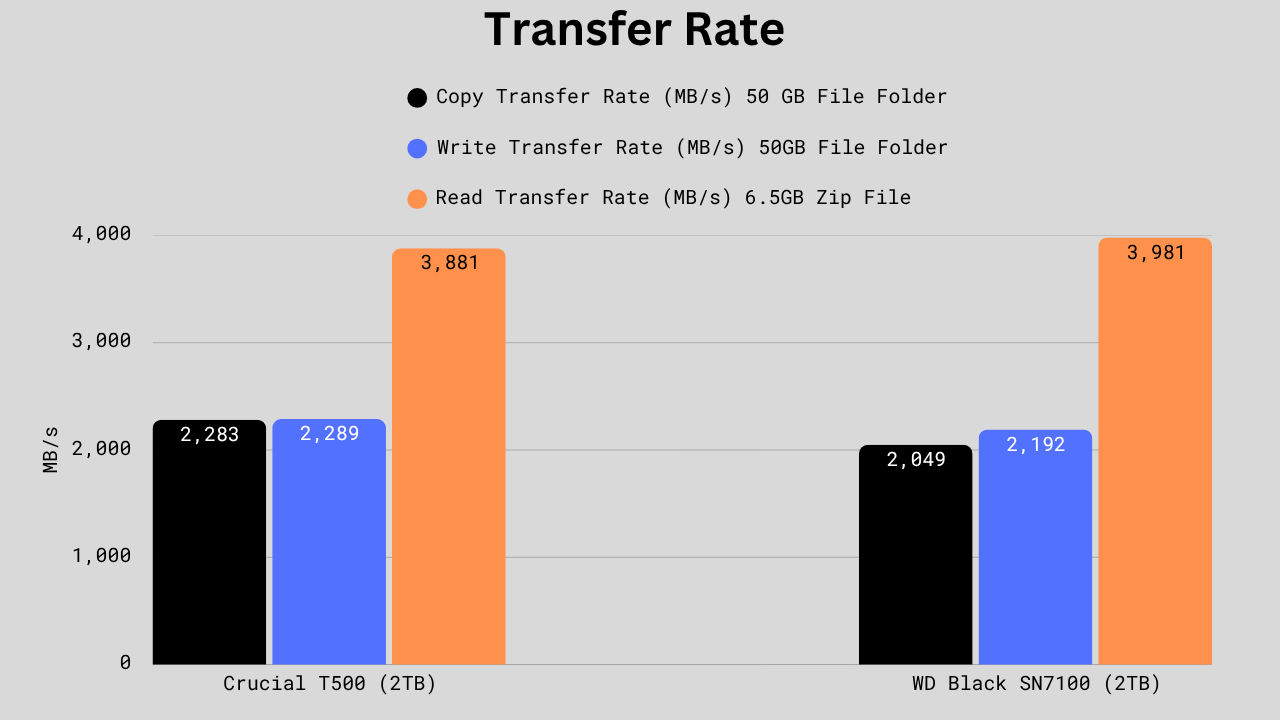
The Crucial T500 shows slightly faster copy and write transfer rates, hitting 2,283 MB/s and 2,289 MB/s versus the WD Black SN7100’s 2,049 MB/s and 2,192 MB/s. The SN7100 comes up with a small win in read speed, at 3,981 MB/s, compared to 3,881 MB/s, but the gap is unnoticeable. Overall, the T500 handles large file transfers a bit more efficiently.
Power Consumption and Efficiency
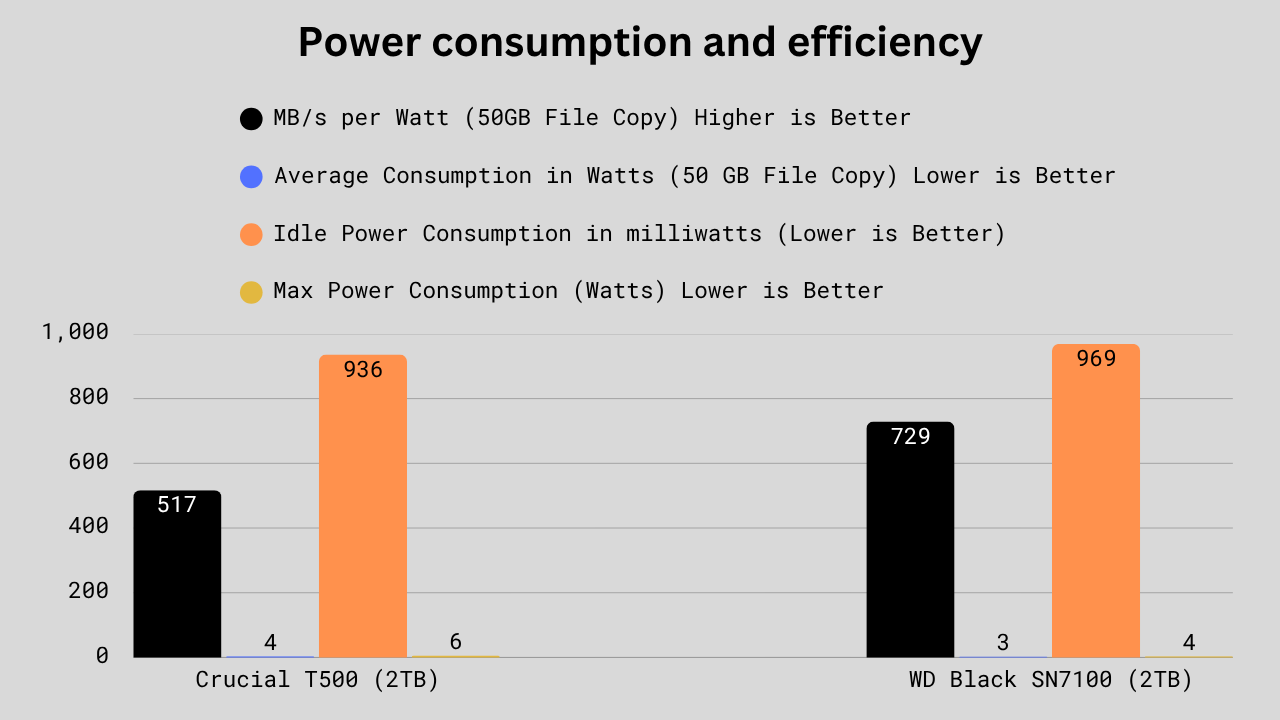
The WD Black SN7100 clearly wins on efficiency, delivering 729 MB/s per watt compared to the Crucial T500’s 517. It also draws less power, 3W average and a 4.10W max, compared to 4W and 6.00W for the T500. Idle power is nearly the same, with just a minor edge to Crucial at 936 mW versus 969 mW. Overall, the SN7100 is a much better choice for systems where power efficiency and lower heat output matter, while the T500 trades that for raw speed.
Steady state write performance
Both these SSDs have the Pseudo-SLC write cache, which handles the incoming data streams of write data. This mechanism is employed because the NAND flash has an inherently slow write speed. So, a cache is assigned to handle the incoming data and store it. When the SSD is in the idle state, this data is written to the actual NAND flash. In normal day-to-day tasks, we may never exceed this write cache but for benchmarking, we can write huge chunks of data to reveal the real-write speed.
So, after exhausting the SLC cache, at 1 MiB and QD32, the SN7100 idles at a write speed of around 850 MB/s. The T500, on the other hand, idles at a massive raw write speed of 4066. So, for tasks like large file copying or anything where big chunks of data is written to your drive, the T500 will give you a better performance.
Thermals
Heat is directly proportional to the workload. However, other factors, such as the DRAM-less design and firmware optimizations, can significantly reduce overall heat. During excessive workloads, the SN7100 idles at around 60-65°C. It comes with no heatsink options. With a good cooling setup, you can even reduce this heat by a significant amount. The T500 can get a little hotter, reaching about 70°C or higher. So, if you are planning to use it under heavy load environments where constant data reading and writing is involved, it is good to opt for the heatsink variant or use other types of active or passive cooling.
TBW, DWPD, MTBF, and Warranty
| Specification | Crucial T500 | WD Black SN7100 |
|---|---|---|
| Endurance (TBW) | 500GB: 300 TBW 1TB: 600 TBW 2TB: 1,200 TBW 4TB: 2,400 TBW | 500GB: 300 TBW 1TB: 600 TBW 2TB: 1,200 TBW 4TB: 2,400 TBW |
| Warranty | 5 Years | 5 Years |
| DWPD | 0.3 | 0.3 |
| MTBF | 2.0 Million Hours | – |
All the endurance specifications are the exact same in both drives. So, there is nothing to compare here.
Technical Specifications
| Specification | Crucial T500 | WD Black SN7100 |
|---|---|---|
| Controller | Phison PS5025-E25 | WD Polaris 3 A101-000103-A1 |
| Controller Architecture | ARM 32-bit Cortex-R5 | ARM Cortex-R |
| Process | 12 nm | 16 nm |
| DRAM Specifications | LPDDR4 DRAM 500GB: 1x 512 MB 1TB: 1×1024 MB 2TB: 1×2048 MB 4TB: 1x 4096 MB | DRAM-Less with Host Memory Buffer |
| SLC Write Cache | 500GB: – 1TB: – approx. 371 GB (dynamic only) 2TB: approx. 720 GB (dynamic only) 4TB: approx. 1950 GB (dynamic only) | 500GB: – 1TB: – 2TB: – 4TB: approx. 650 GB (dynamic only) |
| NAND Flash | Micron B58R FortisFlash TLC | Kioxia BiCS8 |
| NAND speed | 2,400 MT/s | 3600 MT/s |
| Encryption | TCG Opal | Not avaialble |
| SMART/TRIM/PS5 Support | Yes/Yes/Yes | Yes/Yes/Yes |
| Datasheet | Crucial T500 | SN7100 |
The T500 uses a Phison E25 controller built on a newer 12 nm process, while the SN7100’s WD Polaris controller is built on a 16 nm process, so Crucial has a slight edge in efficiency and thermal performance. The T500 also includes LPDDR4 DRAM for faster caching, whereas the SN7100 goes DRAM-less and relies on Host Memory Buffer, which saves cost but limits sustained performance.
On the flip side, WD’s BiCS8 NAND runs faster at 3600 MT/s compared to Crucial’s 2400 MT/s Micron TLC, though Crucial compensates with a larger SLC write cache on higher-capacity models. The T500 further stands out with TCG Opal encryption support, which WD just skips. Overall, the T500 is the more feature-rich and balanced drive, while the SN7100 prioritizes efficiency and cost over raw flexibility.
Price
By the time I am writing this article, the 500GB T500 is selling for 72.99$, which is a price tag we expect from any high-end or flagship SSD. The 500GB SN7100 is available for 59.99$, which is 13$ cheaper than the T500. The 1TB T500 is $12 more expensive than the SN7100. The price gap reached its peak when I saw the price difference of 136$ in the 4TB variant. However, keep note that these prices keep changing and you may get different discounts in the sales seasons. So, make sure to double-check and compare the prices before you make your final decision.


Conclusion: Which One Should You Choose?
If you want a solid all-around SSD with strong performance in reads, writes, latency, and features, then the Crucial T500 is the choice. It handles heavy workloads like think gaming, video editing, and large file transfers pretty well. It provides encryption support and onboard DRAM, which improves consistency and responsiveness. So, overall, good performance, the T500 is the right pick, but you will have to pay a little more. But I would say this extra money is worth it for the performance gains you receive.
If your priorities are power efficiency and lower cost, and you’re mainly working with everyday computing like web browsing, office apps, streaming, and moderate file work, then the WD Black SN7100 makes more sense. It may not beat the T500 at every metric, but it performs very well where it counts and does so more cleanly in terms of wattage and heat.
In short, pick the T500 for performance-heavy use and choose the SN7100 for efficient, reliable performance in more typical use cases.





